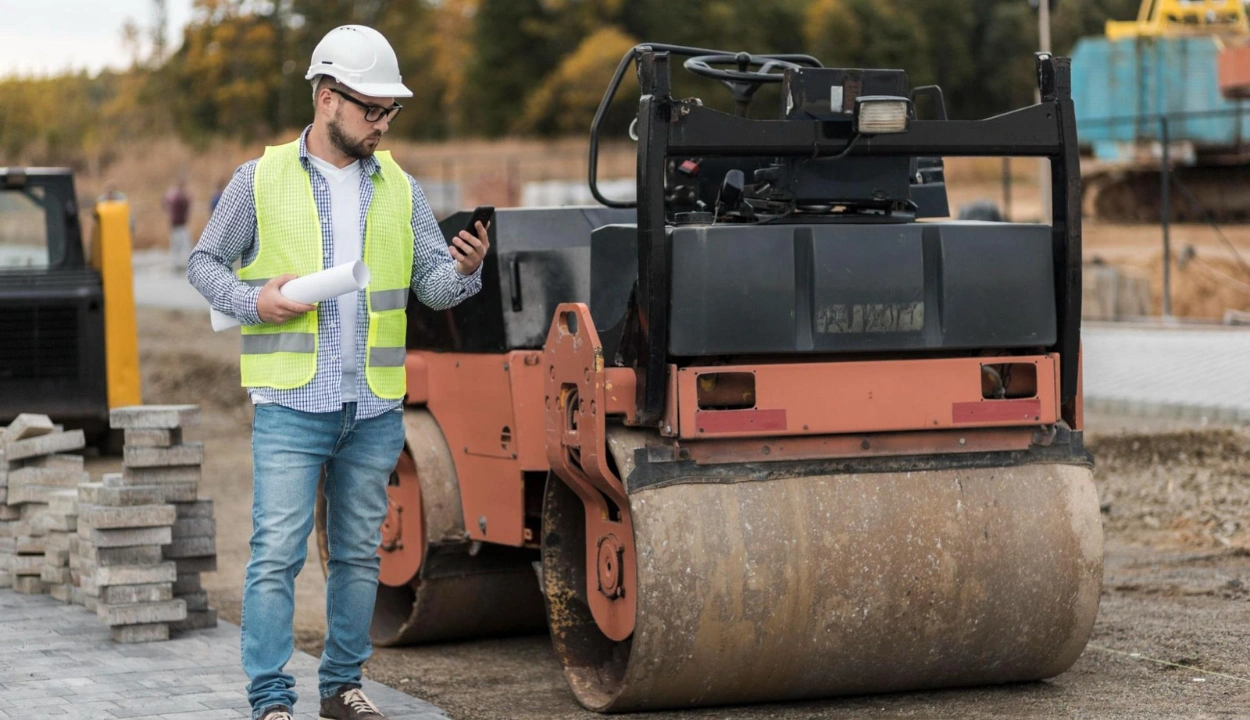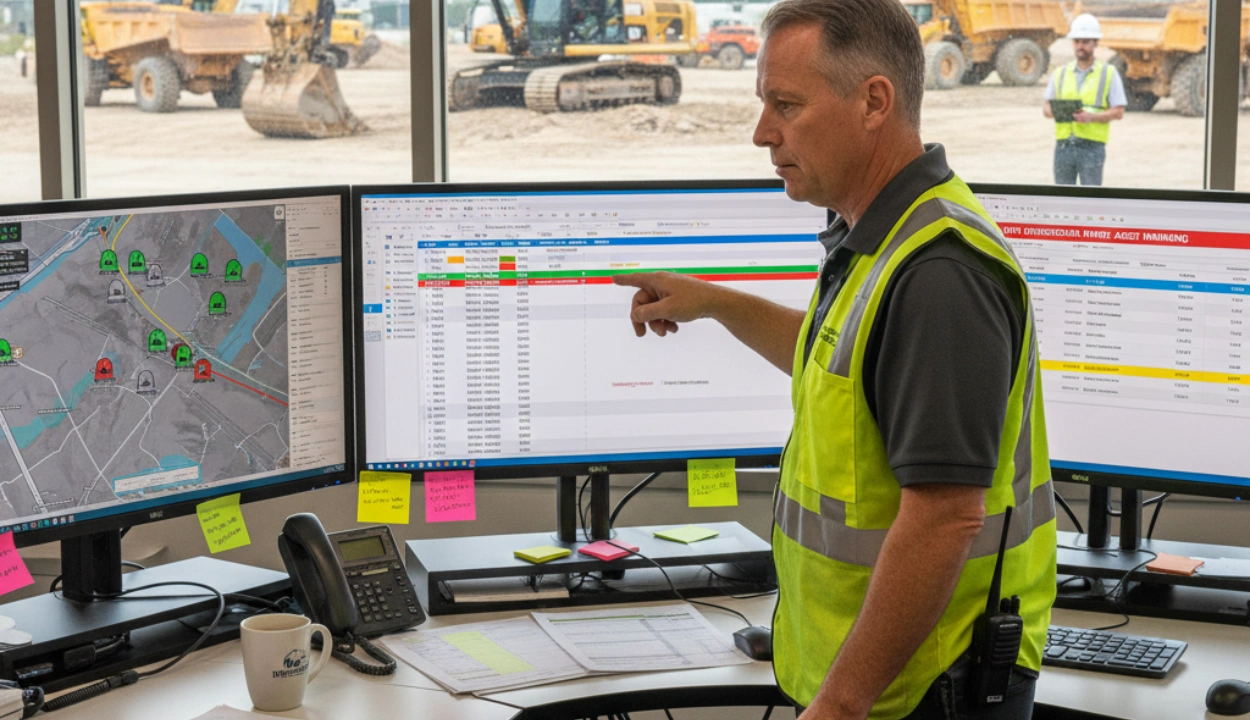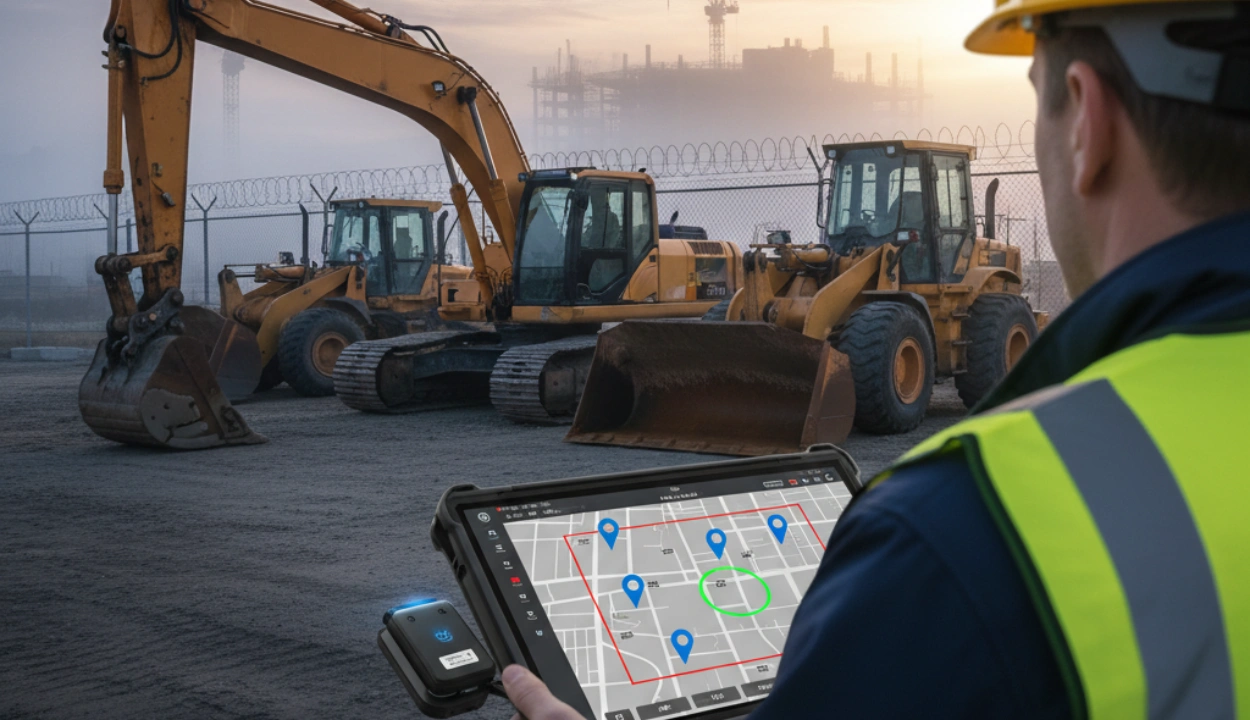Top 10 Construction Equipment Software for Environment Sustainability
The concept of sustainability in construction is no longer a peripheral activity, it is a performance indicator that has a direct impact on bids, client perception and operational expenses. As emissions are now regulated more, and ESG expectations are increasing, contractors are not only being evaluated based on their productivity, but also at the rate at which they relocate earth, materials, and fuel in an efficient and responsible way.
Modern equipment software is becoming central to that shift. These platforms connect telematics, maintenance, and fuel data to reveal where waste happens; idling, over-trucking, under-utilization and turn those insights into measurable CO2 and cost reductions.
The best systems don’t just track, they help you act, optimizing fleet size, engine efficiency, and on-site energy use.
This blog highlights ten construction-specific platforms leading the way in environmental sustainability.
How We Picked (Ranking Criteria)
- Fuel & Idle Reduction. Builtin fuel tracking with configurable idle thresholds and alerts for after‑hours or unauthorized use, plus fuel‑card and bulk‑tank connections, so actual burn is reconciled, not guessed.
- Emissions Tracking & ESG Exports. Converts fuel and engine data into CO₂ by asset, job, and month, and provides clean CSV/PDF/API exports so ESG teams and clients can reuse the numbers without rework.
- Energy‑Efficient Operations. Provides utilization dashboards, geofences, and simple move/dispatch helpers to cut idle and deadhead; adds operator coaching and auto‑shutdown policies so guidance becomes action.
- Lifecycle Optimization. Uses usage‑ and condition‑based PM tied to fuel economy, with repair‑vs‑replace/TCO views and fault‑driven service to keep engines in their most efficient band.
- Unified view & Integrations. Ingests AEMP 2.0/OEM feeds (Cat, Komatsu, Deere, Volvo, etc.) and connects to fuel cards and open APIs so all brands, rentals, and fuel data live in one place.
- Owner‑ready Reports. Produces a one‑click monthly reports, fuel used, idle %, CO2 by site/asset, and actions taken, ready to share with clients and leadership.
- Fewer Wasted Miles. Uses geofences and route/move suggestions to shrink deadhead and gate‑queue idling, with alerts that prompt the field to act.
Quick‑scan Comparison Matrix
The Top 10 Construction Equipment Software for Environmental Sustainability
1) Clue - Construction‑native, fuel/idle/utilization in one pane
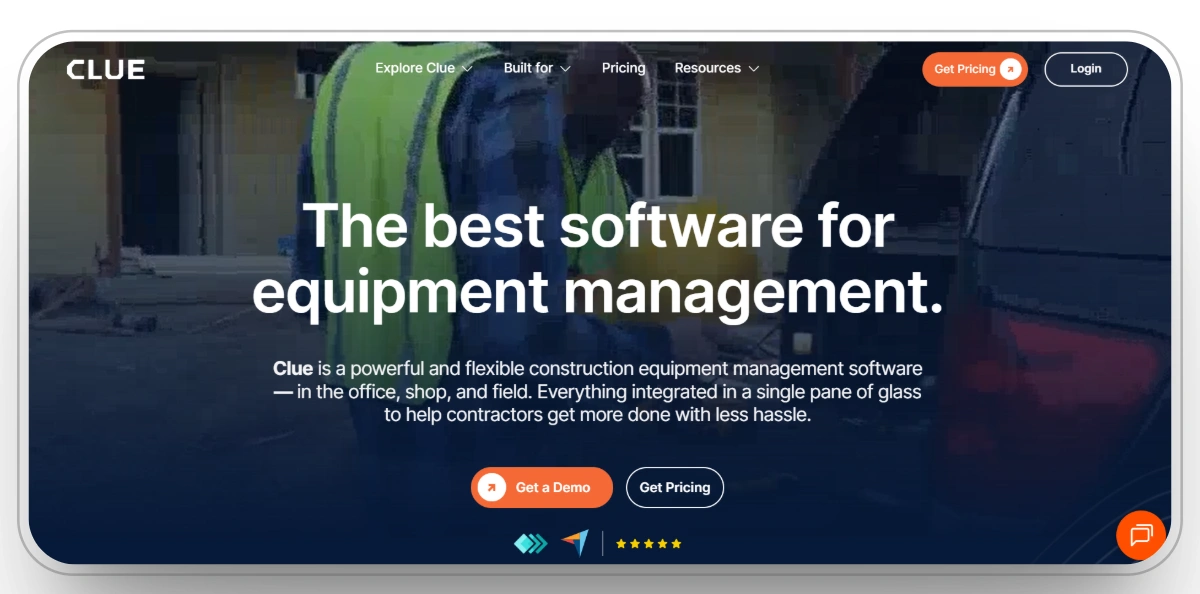
Best for: Contractors who want mixed‑fleet sustainability
Clue brings AEMP/OEM telematics, GPS, and fuel-card or tank data together with usage-based preventive maintenance to help contractors cut fuel burn and CO2 and promote across mixed fleets. It enforces idle policies by site, asset, and shift, and flags after-hours or unauthorized runtime. It also converts fuel data into CO2 totals with ready-to-share CSV or PDF ESG reports.
Its utilization heatmaps and cycle-time analytics expose redundant units and low-load operation, so teams can park, reassign, or return equipment early to shrink carbon impact and rental costs.
Maintenance work orders triggered by hours, odometer, or fault codes keep engines running efficiently and confirm post-service fuel improvements through automatic before-and-after data comparisons.
Beyond dashboards, Clue gives superintendents and shop leads role-based views and mobile access so they can act on high-impact savings right from the field. AI-driven productivity insights highlight idle clusters, excessive transport runs, and underused assets at each jobsite, turning emissions data into clear operational steps.
Combined with integrations (Cat, Komatsu, Deere, Volvo) and fuel-source inputs, Clue creates a single environmental performance record for the entire equipment fleet.
Clue’s Key Features
- Emission Insights: Clue delivers precise, real-time CO₂ estimates per asset by pulling data from telematics, fuel management, and engine hours. This ensures that each asset’s contribution to overall project emissions is transparent and trackable.
- Eco-Friendly Analytics: Clue transforms operational data (engine hours, idle time, usage) into actionable sustainability metrics. These insights empower managers to minimize fuel waste, enhance energy use, and showcase measurable environmental impact through data-driven decisions.
- Carbon Track Dashboard: The dashboard aggregates CO2 emissions by asset, providing a clear Carbon Intensity Metric (CIM) based on fuel type and jobsite conditions. This allows managers to benchmark equipment performance and provide verified emissions data to ESG teams or clients.
- Fuel Flexibility: Allocate each asset to a specific fuel profile (diesel, biodiesel, electric, etc.)with Clue and perform a more precise emission tracking and sustainability reporting to your mixed fleet composition.
- Eco Operation Mapping: Interactive site maps in Clue demonstrate assets that are not performing their tasks efficiently and those that are idling; allowing teams to make changes to their workflows to reduce unnecessary fuel consumption and emissions.
- Green Compliance Reports and Analytics: Clue streamlines sustainability and environmental compliance reporting, which fits the federal and project-owner requirements, and generates pre-ready ESG reports on request.
- Sustainable Usage Stats: Utilization and maintenance monitoring ensured through usage are useful in maintaining engines at optimum efficiency levels and increasing the life of equipment as well as minimizing carbon emissions.
- Eco Audit Trails: All the sustainability measures including the idle reduction and PMs as well as the emission checks are time-stamped and logged to be audited to create a defensible and data-supported sustainability history.
Clue Pros
- Pulls carbon and fuel data directly from AEMP/OEM feeds instead of relying only on manual fuel logs.
- Converts fuel use to CO2 intensity per machine hour, letting contractors benchmark the environmental cost of every asset.
- Ties idle alerts to site, shift, and project budgets, so sustainability actions actually tie into operations and cost savings (not just green reporting).
- Combines utilization and emissions in one dashboard, helping teams spot when underused assets are wasting fuel
- Supports mixed fuel types and hybrid assets (diesel, biodiesel, EVs) for precise emissions modeling across construction-specific fleets, where most tools assume on-road only.
Clue Cons
- Requires accurate fuel and telematics data for full precision.
Clue Rating
Capterra: 4.6/5
G2: 4.5/5
2) Trackunit
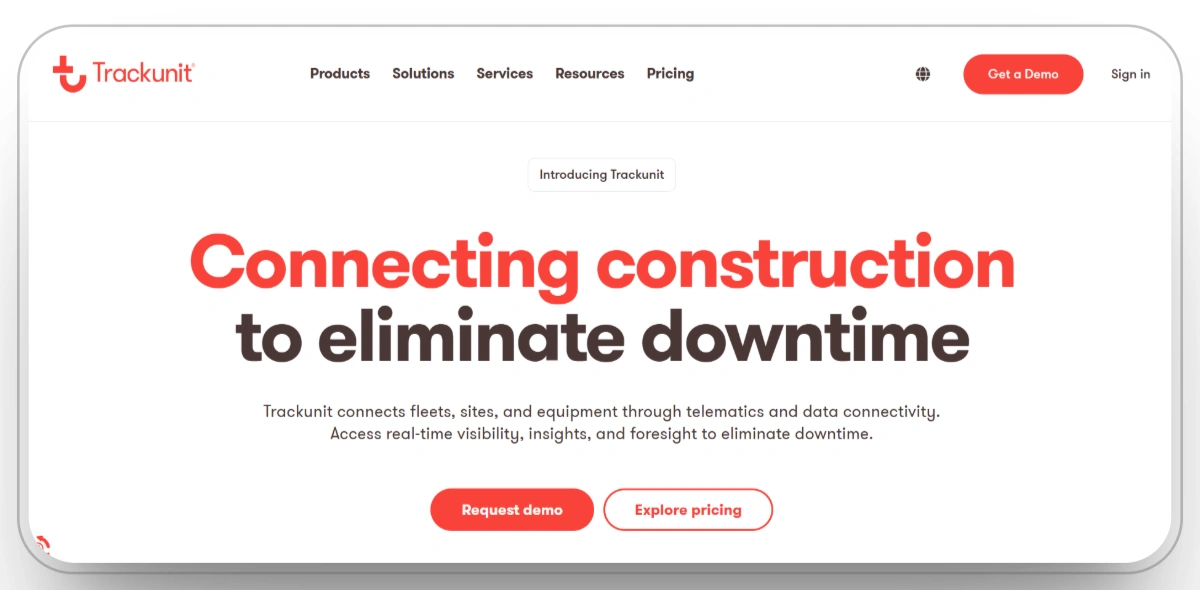
Best for: Heavy civil firms that want run‑time accuracy
Trackunit connects heavy equipment and small tools through Bluetooth and telematics to reveal actual run time versus idle, eliminating hidden idle and unnecessary rentals. Predictive maintenance detects inefficiencies like clogged filters or poor combustion that increase fuel use, while site heatmaps pinpoint the worst waste areas. CO2 summaries by project and asset type visualize sustainability improvements after policy changes, and multi-brand ingest with retrofit options ensures coverage across new and legacy fleets without complex IT setup.
However, accurate results depend on full telematics coverage; CO2 benchmarking setup can take time; fuel integration isn’t as seamless as Clue; the analytics dashboard can feel complex initially; and advanced sustainability modules come at a higher subscription cost.
Trackunit Pros
- Tracks true run-time versus idle across all equipment types, cutting hidden idle and unnecessary rentals.
- Predictive maintenance identifies inefficient engine conditions that increase fuel consumption.
- Provides CO2 tracking by project and asset category for sustainability benchmarking.
- Works with both OEM telematics and retrofit Bluetooth tags, ensuring full-fleet coverage.
- Heatmaps highlight waste and underutilized assets to support emission-reduction decisions.
Trackunit Cons
- Requires strong device coverage for precise fuel and emission data.
- CO₂ tracking setup and calibration can be time-intensive.
- Limited native integration for direct fuel data capture.
- Dashboards can feel complex to interpret for first-time users.
- Advanced analytics and sustainability modules cost extra for full access.
Trackunit Rating
Capterra: 4.3/5
G2: 3.2/5
3) B2W Maintain
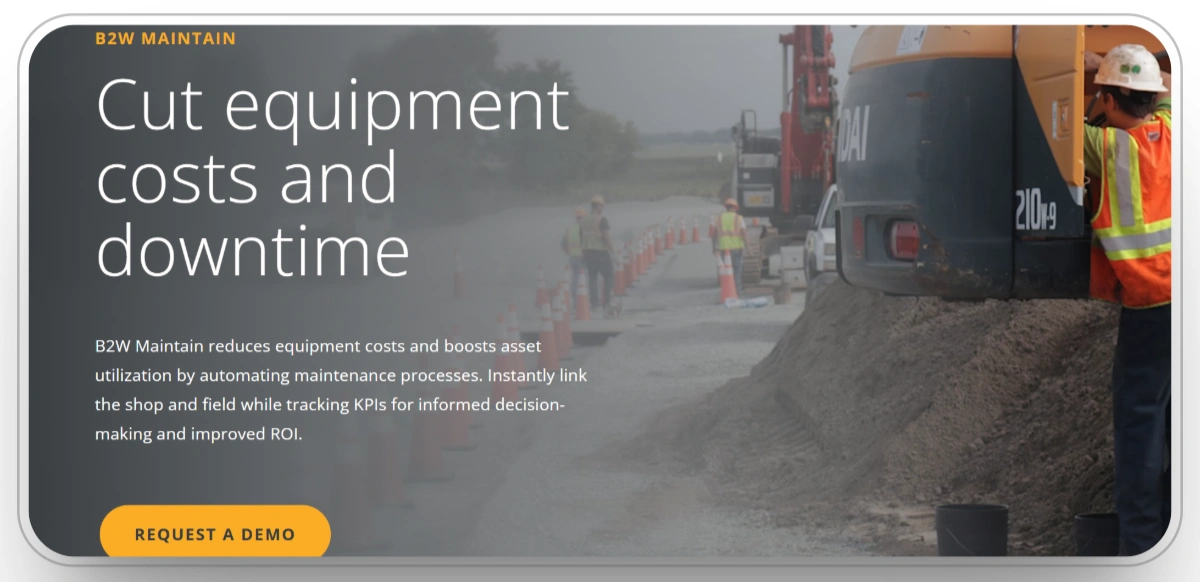
Best for: Contractors who want integrated repair & maintenance control
B2W Maintain is a construction-oriented maintenance management module that is part of the B2W suite. It enables field crews to record repairs, inspections and service events along with project workflows without interrupting the process flow, while connecting actions to fleet and utilization data to track efficiency.
By tying maintenance work orders to operating metrics (engine hours, faults, idle), B2W helps teams prioritize service tasks that yield the biggest fuel or emissions benefit. While B2W Maintain is not a telematics provider itself, it connects to existing fleet systems to provide a unified “repair + efficiency” picture, so decisions around maintenance, downtime, and asset deployment all support sustainability goals.
B2W Maintain Pros
- Connects maintenance workflows with equipment performance data for measurable efficiency gains.
- Prioritizes repairs based on real fuel and utilization data to target high-impact fixes.
- Integrates with external telematics systems to centralize fleet and service information.
- Operates within the broader B2W suite for unified planning, dispatch, and asset control.
- Logs repair history against operating data to assess asset efficiency over time.
B2W Maintain Cons
- Doesn’t natively provide telematics or sensor data; must rely on external integrations for fuel/idle info.
- Emissions reporting features are limited compared to pure sustainability software.
- Users may need training to align field repair workflows with efficiency priorities.
- Integration setup can require IT support, especially across legacy systems.
- Its strength is in maintenance control more than real-time routing or geofencing analytics.
B2W Maintain Rating
Capterra: 4.4/5
G2: 4/5
4) Michelin Connected Fleet
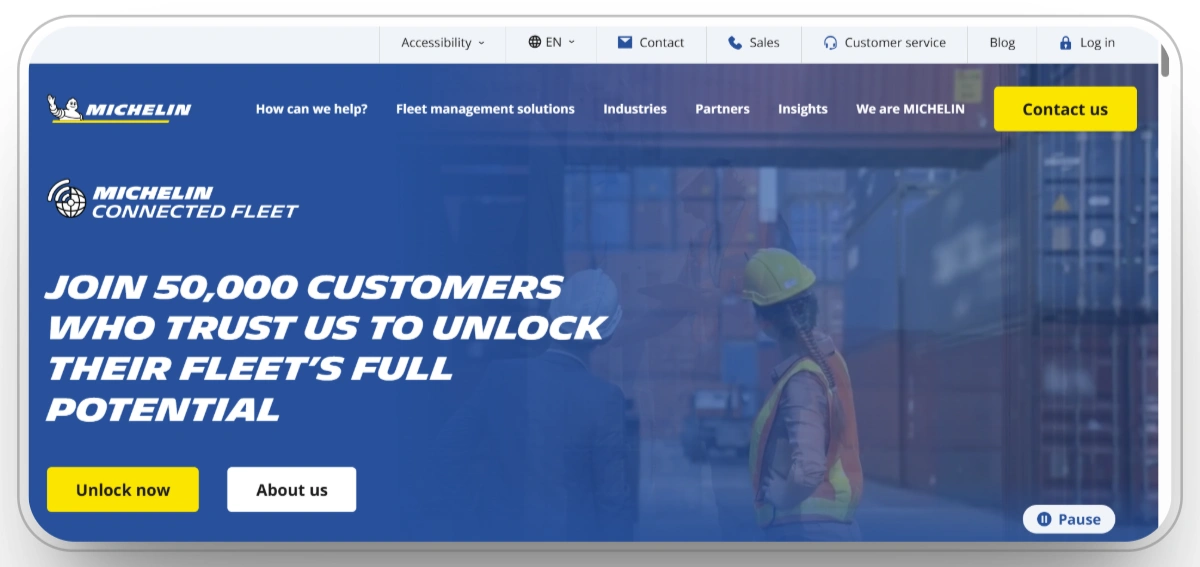
Best for: Construction firms focused on fuel efficiency and emissions
Michelin Connected Fleet is a heavy equipment and mixed fleet fleet telematics platform. The main strength of it is that it minimizes the use of excess fuel and reduces the CO2 emission through maximization of utilization, idle time, and efficiency of the route.
The system is combined with OEM telematics and fuel sensors to check the machine behavior and indicate the inefficiencies in real-time. It offers dashboards and reports related to the fuel intensity and emissions data, and these data assist fleet managers to make information-based decisions on equipment deployment, maintenance, and contract renewal.
Michelin Connected Fleet Pros
- Focus on fuel efficiency and CO2 reduction as central metrics, not add-ons.
- Integrates with OEM telematics and fuel sensor hardware for data accuracy.
- Offers dashboards and alerts around idle, fuel burn, and utilization.
- Useful for firms already familiar with Michelin products and ecosystem.
Michelin Connected Fleet Cons
- Less mature in construction-specific features (e.g., earthmoving cycles, attachment tracking).
- Emissions/export reporting may not be as customizable as niche sustainability platforms.
- Integration with non-Michelin systems may require extra development.
- Lower adoption in construction might lead to fewer reference cases.
- Advanced modules or premium analytics may add to license costs.
Michelin Connected Fleet Rating
Capterra: 3.4/5
G2: 4.8/5
5) Samsara
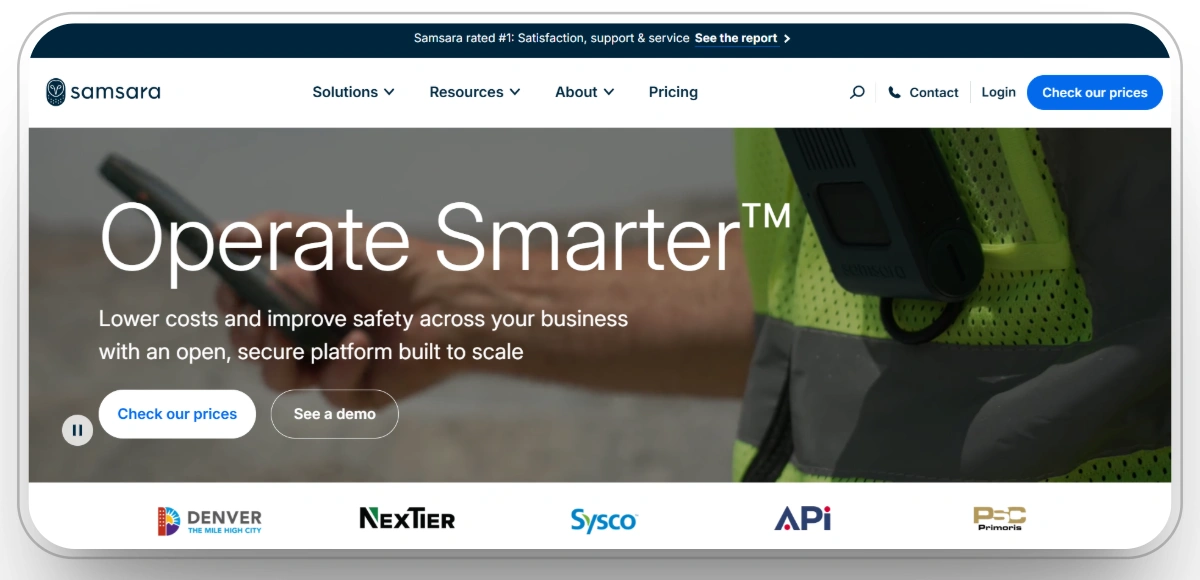
Best for: Fleets wanting IoT breadth, fuel/idle, emissions reports, and route efficiency
Samsara integrates GPS positioning, engine diagnostics, and driver behavior analytics in order to assist contractors to reduce emissions and fuel consumption in mixed fleets. The platform monitors idle time, rough acceleration, off route miles, and health of the vehicle in real time so that even the exact points of improvement of CO2 and fuel efficiency can be identified.
In addition to the tracking, Samsara connects sustainability to maintenance and driver processes. Automation of DVIR to work order is used to ensure that such problems as tire pressure, leaks, or clogged filters are resolved in time, to avoid poor combustion and excessive emissions.
Samsara Pros
- Tracks idle, off-route, and high fuel-burn events in real time using GPS and engine diagnostics.
- Scores drivers on efficiency to reduce idling and harsh acceleration or braking.
- Optimizes routes and geofences to cut unnecessary trips and queue idling.
- Converts inspection findings (like leaks or low tire pressure) directly into repair tasks.
- Generates CO₂ and fuel-efficiency dashboards for quick sustainability tracking.
Samsara Cons
- Expensive hardware and licenses for small fleets.
- Limited customization for sustainability reporting.
- Depends on cellular coverage for live data.
- Integration with external systems can require manual setup.
- Driver scoring may need tuning to account for terrain or load differences.
Samsara Rating
Capterra: 4.4/5
G2: 4.6/5
6) Geotab

Best for: Large or growing fleets that need deep analytics
Geotab excels in sustainability analytics by turning telematics data into actionable fuel- and emission-reduction insights. Its Green Fleet Dashboard aggregates trip data, duty cycles, and idle time to calculate CO2 output and fuel waste across thousands of assets. Rule-based alerts flag anomalies such as excessive idle, aggressive acceleration, or inefficient routing, allowing managers to correct waste in real time.
Beyond tracking, Geotab’s Marketplace ecosystem extends sustainability capabilities with route-optimization apps, fuel card integrations, and third-party ESG connectors that automate emissions reporting. The platform’s energy-intensity comparison view unifies diesel, hybrid, and electric units, enabling contractors to benchmark performance, identify electrification opportunities, and dispatch the lowest-emission option for each job.
Geotab Pros
- Green Fleet Dashboard gives precise fuel and CO₂ data across large fleets.
- Duty-cycle analysis identifies wasted idling and under-used equipment.
- Rule-based alerts surface real-time fuel and route inefficiencies.
- Integrates with fuel cards, ESG systems, and route tools for complete tracking.
- Supports mixed powertrains for diesel, hybrid, and EV comparison.
Geotab Cons
- Expensive hardware and licenses for small fleets.
- Limited customization for sustainability reporting.
- Depends on cellular coverage for live data.
- Integration with external systems can require manual setup.
- Driver scoring may need tuning to account for terrain or load differences.
Geotab Rating
Capterra: 4.4/5
G2: 4.4/5
7) MachineMax
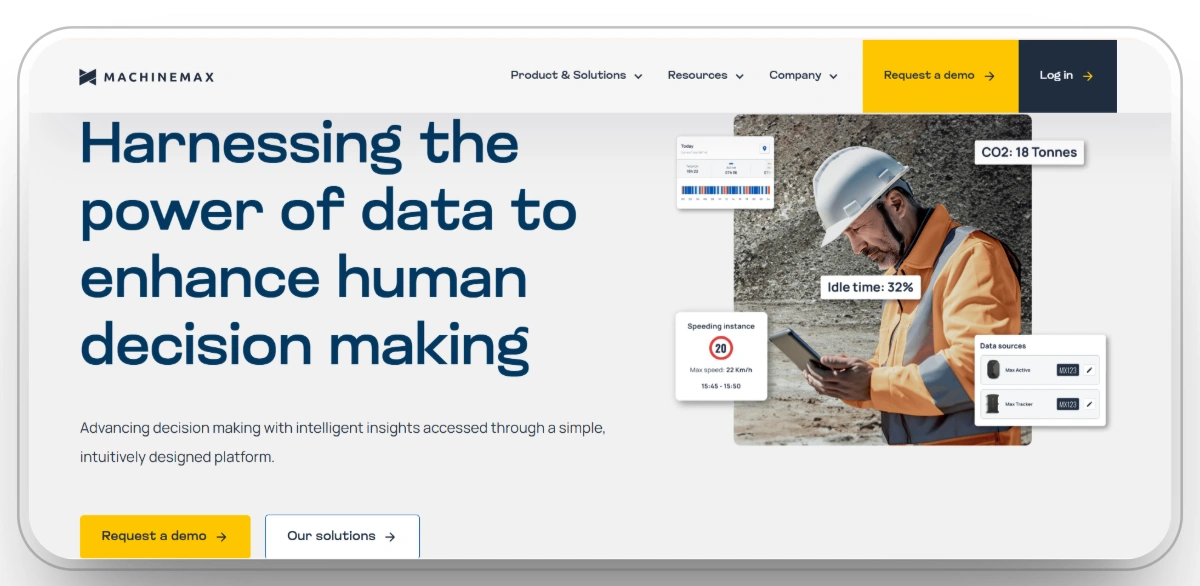
Best for: Rapid idle‑reduction on mixed brands, including assets lacking factory telematics
MachineMax helps contractors cut idle time and emissions fast by using retrofit sensors alongside OEM feeds to capture accurate run-vs-idle data on every machine, even older units without built-in telematics.
Within weeks, the platform highlights idle hotspots by site, shift, and operator, giving supervisors clear data to enforce shutdown policies and optimize equipment rotation. Its dashboards display CO2 and fuel burn trends in simple visual formats that connect field actions directly to measurable carbon savings. Because it installs in minutes and works across brands, MachineMax delivers one of the quickest sustainability returns of any fleet monitoring solution.
MachineMax Pros
- Retrofit sensors make non-telematic assets instantly trackable for fuel and idle reporting.
- Quick deployment (30–60 days) yields measurable CO2 and fuel savings
- Real-time idle detection helps supervisors target specific crews or shifts for action.
- Cross-OEM coverage unifies old and new equipment under one utilization dashboard.
- Clear CO2 and utilization visuals make sustainability impact easy to communicate to stakeholders.
MachineMax Cons
- Limited integration depth compared to full CMMS or telematics stacks.
- Analytics are focused on idle and utilization, not full maintenance tracking.
- Requires sensor installation and calibration for non-OEM units.
- Fewer customization options for ESG exports than enterprise platforms.
- Lacks advanced route optimization or driver-behavior modules found in fleet-first tools.
MachineMax Rating
Capterra: N/A
G2: N/A
8) EquipmentShare T3
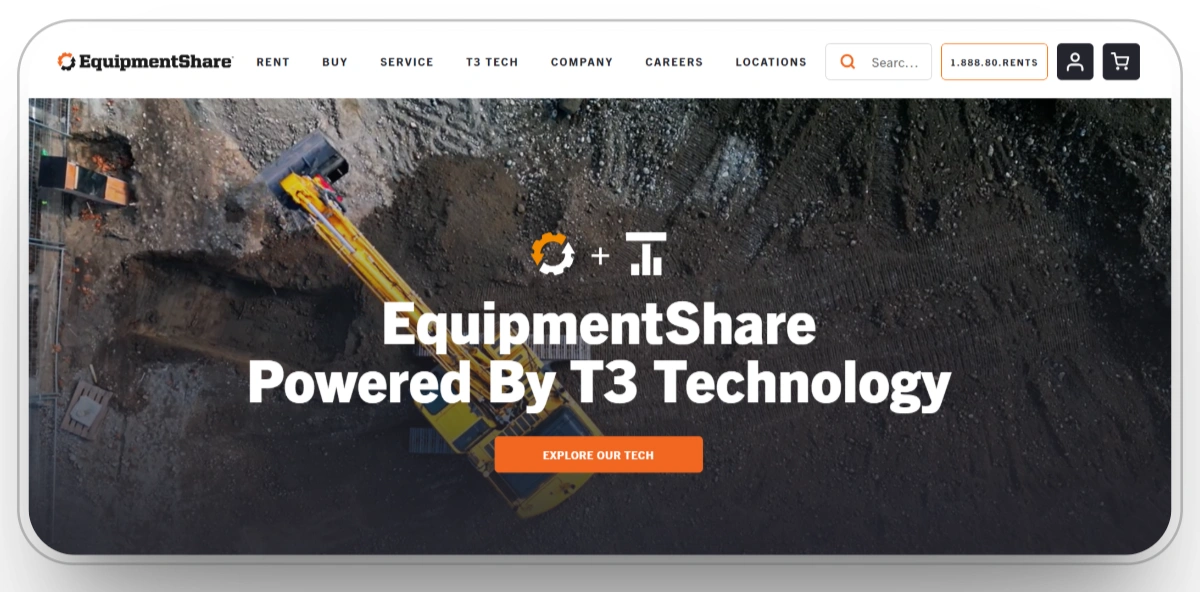
Best for: Contractors blending owned and rented assets who want site‑level sustainability KPIs.
EquipmentShare’s T3 platform gives construction teams a unified view of owned and rented equipment to pinpoint inefficiencies that drive unnecessary fuel burn and emissions. By overlaying utilization, idle, and cost data, T3 helps identify duplicate or underused machines and provides prompts for early rental returns, reducing both overhead and CO2 output.
Site dashboards highlight idle trends, after-hours use, and theft, while automated maintenance tickets prioritize equipment that wastes the most fuel. Post-service verification ensures that every repair or return produces measurable sustainability gains. T3 essentially turns environmental impact into a tracked operational KPI visible to project managers, foremen, and finance teams alike.
EquipmentShare T3 Pros
- Merges owned and rented assets for full fuel and idle visibility.
- Highlights redundant or idle equipment for early off-hire.
- Prioritizes maintenance that yields direct fuel savings.
- Verifies post-repair fuel reduction with live data.
- Includes CO2 and cost overlays for data-driven return decisions.
EquipmentShare T3 Cons
- Limited integration with third-party telematics providers.
- Relies on consistent data entry from field users.
- CO2 estimates vary with incomplete fuel inputs.
- ESG export options are basic.
- Data sync from OEM sources can delay real-time reporting slightly.
EquipmentShare T3 Rating
Capterra: N/A
G2: N/A
9) Komatsu Smart Construction Fleet

Best for: Earthmoving operations wanting production vs idle clarity
Komatsu’s Smart Construction Fleet is purpose-built for heavy earthmoving, mapping production, idle, and fuel burn in one view. It reveals how long equipment wait at load and dump points, where queues form, and which haul routes waste the most fuel. Supervisors can adjust routes or dispatch timing to cut idle miles and cycle fuel.
The system combines OEM and AEMP 2.0 data from Komatsu and other brands, giving one unified dashboard of utilization, fuel rate, and CO2 per project. Exportable sustainability tiles summarize production, idle %, and emissions for weekly owner or GC reports.
Komatsu Pros
- Puts production, idle, and fuel metrics side-by-side for clear efficiency tracking.
- Route and queue analytics pinpoint choke points that drive fuel waste.
- Works with AEMP 2.0 data across mixed OEM fleets.
- Provides exportable sustainability summaries for project and owner reporting
- Enables quick adjustments that reduce over-trucking and idle time.
Komatsu Cons
- Optimized mainly for earthmoving, less suited to vertical or mixed trades.
- Limited custom reporting beyond Komatsu’s dashboard format.
- Dependent on consistent OEM telematics data feeds.
- Requires setup coordination between on-site operations and digital teams.
- Lacks deeper maintenance or ESG documentation tools beyond performance data.
Komatsu Rating
Capterra: N/A
G2: N/A
10) Verizon Connect
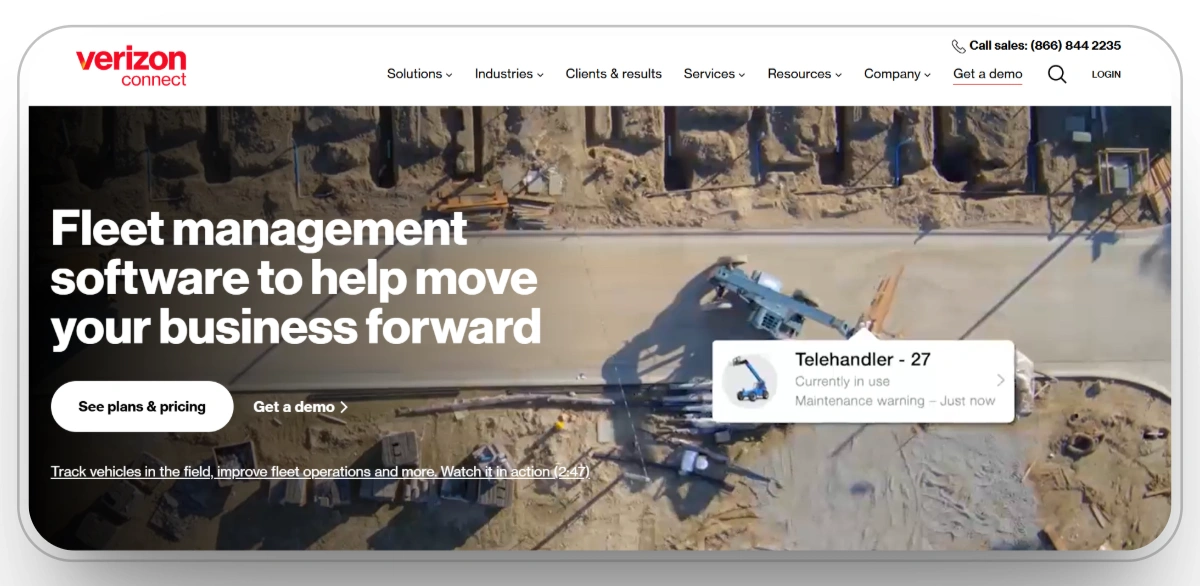
Best for: Firms that want broad telematics with routing/geofencing
Verizon Connect provides wide-reaching telematics and sustainability oversight for fleets operating across multiple job sites or regions. The system enforces idle, speed, and route policies per asset or geofence, helping managers reduce engine-on time and unnecessary trips that inflate both costs and emissions. Real-time location data, paired with route optimization, trims fuel burn across dispatch and delivery routes.
The platform’s integrated fuel card tracking exposes irregularities, such as unplanned refuels or fuel theft and connects consumption data with mileage to estimate CO2 output. Dashboards and simple ESG exports allow users to consolidate sustainability metrics for reporting or client communication.
As a versatile, cloud-based telematics layer, Verizon Connect fits fleets looking for scalable fuel and emissions visibility without restructuring their existing systems or maintenance stack.
Verizon Connect Pros
- Enforces route, idle, and geofence rules by vehicle or job site.
- Integrates with fuel cards to detect waste and anomalies.
- Converts mileage and fuel data into CO2 metrics for ESG reports.
- Optimizes routing and dispatch to cut total driven miles.
- Scales easily across fleets and integrates with legacy systems.
Verizon Connect Cons
- Emissions reporting is basic compared to sustainability-focused tools.
- Limited visibility into non-road construction assets.
- No predictive maintenance or lifecycle efficiency analysis.
- Dashboard customization is minimal for advanced users.
- Data sync lag can occur in large or multi-region deployments.
Verizon Connect Rating
Capterra: 3.2/5
G2: 3.8/5
Implementation Tips for Greener Equipment Ops
- Start with idle: Set site‑specific idle thresholds and after‑hours alerts; review weekly exceptions and coach operators.
- Right‑size every month: Use utilization reports to park, swap, or return under‑used units; avoid duplicate rentals.
- Tie PM to efficiency: Enforce usage‑based PM so engines stay tuned; track post‑service fuel KPIs to verify impact.
- Consolidate fuel data: Pull card, tank, and telematics fuel information into one dashboard; reconcile anomalies to catch waste and theft.
- Export a sustainability pack: Monthly CSV/PDF of fuel used, idle %, CO2 per site/asset, corrective actions, and next‑month targets, evidence for clients and leadership.
Choose the Right Sustainability Stack (Quick Guide)
- Choose Clue if you want the most construction‑centric mix of fuel/idle reduction, right‑sizing, and clean ESG exports in one pane.
- Choose Trackunit if you need run‑time accuracy and tool tagging to eliminate hidden idle on complex sites.
- Choose Tenna if dispersed jobs demand one place for fuel/idle/CO2 with strong redeploy/return prompts.
- Choose HCSS Telematics + E360 if you want shop performance directly linked to fuel efficiency.
- Choose Samsara if you want IoT depth for route/driver efficiency with emissions dashboards.
- Choose Geotab if analytics‑heavy CO2 reporting and marketplace add‑ons matter.
- Choose MachineMax if you need fast idle cuts on older or non‑telematic machines.
- Choose EquipmentShare T3 if you juggle rented + owned assets and want site‑level CO₂.
- Choose Komatsu Smart Construction Fleet if you’re earthmoving‑heavy and need production vs idle clarity.
- Choose Verizon Connect if routing/geofencing plus basic emissions tracking are primary.
The Bottom Line
True environmental sustainability in construction equipment management starts with visibility, knowing exactly where fuel, idle hours, and emissions are coming from. The next step is action: right-sizing fleets, cutting idle time, and maintaining engines at peak efficiency to lock in those fuel and CO2 savings over time.
A purpose-built platform should not just report numbers, it should help you act on them daily. Whether that means parking underused assets, optimizing haul routes, or measuring CO₂ per yard moved, the best tools turn sustainability into measurable ROI.
If you want a construction-native platform that unites telematics, fuel data, and emissions reporting without needing six integrations, Clue is your most complete starting point for building a lower-carbon fleet.
FAQs
1. What is sustainable fleet management and how does it reduce costs?
Sustainable fleet management cuts emissions and fuel use by tracking idle time, optimizing dispatch, and maintaining engines efficiently. Data from telematics identifies waste and helps schedule repairs or route changes that lower fuel burn. The result is less CO₂, reduced operating costs, and longer equipment life.
2. How does telematics support construction equipment sustainability?
Telematics provides real-time data on fuel use, idle time, and engine performance. It flags inefficiencies and mechanical faults that raise emissions, letting teams act fast. Combined with maintenance tools, it enables condition-based servicing,keeping engines efficient and emissions low.
3. What features should construction fleet software include for emissions tracking?
The software should track fuel burn, idle ratios, and CO₂ output by equipment type, and export reports for ESG or client audits. It must support mixed fleets via AEMP 2.0/OEM data, customizable idle alerts, and integrations with maintenance logs to link fixes directly to emission improvements.
Transform Your Equipment Management









